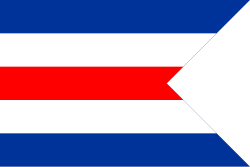Allied Military Government of Occupied Territories | |
|---|---|
Flag | |
| Official languages | |
| Type | Military occupation government |
| Currency | Allied Military Currency |
The Allied Military Government of Occupied Territories (originally abbreviated AMGOT, later AMG) was the form of military rule administered by Allied forces during and after World War II within former Axis-held territories they occupied. [1] The first instance of this inter-Allied model of government of occupied territory was manifested in Sicily after Operation Husky in August 1943. [2]


